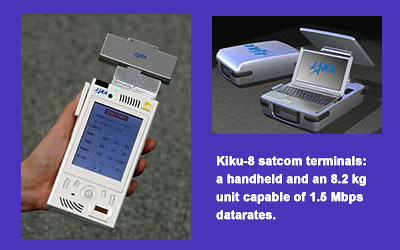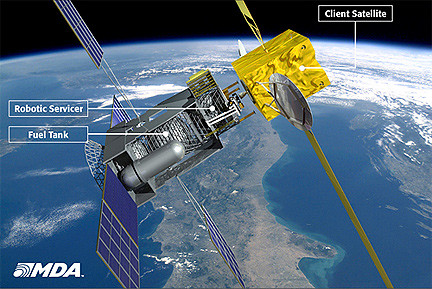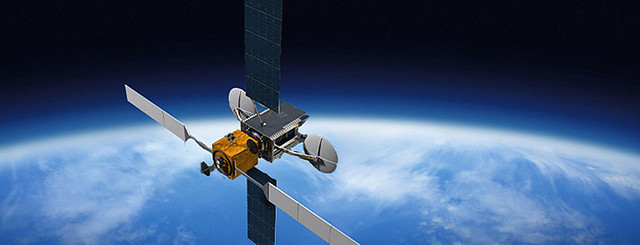WBMSAT Satellite Industry News Bits 04/15/2011
Friday, April 15th, 2011Global satellite machine-to-Machine (M2M) service revenues to reach $1.7B by 2017 according to new Gobal Industry Analysts report.
[San Francisco Chronicle – 04/15/2011]
U.S. Defense Information Systems Agency wants to lease a single commercial satellite for 15 years for $440M, meeting 78% of U.S. Central Command’s requirements in Afghanistan and Iraq while dramatically cutting costs.
[Next Gov – 04/15/2011]
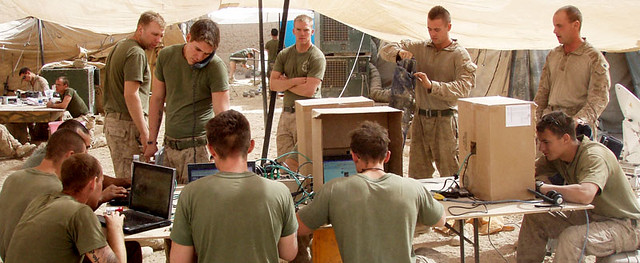
Cheetah “Morale Satellite” system provides free phone calls home and fast Internet connectivity for soldiers in Afghanistan.
[DIVIDS – 04/15/2011]
Comtech receives $1.2M satellite ground station equipment order from a large integrator for a military requirement in a Latin American country.
[Your Industry News – 04/15/2011]
Senators Pat Roberts (R-Kan) and Ben Nelson (D-Neb) in an open letter ask fellow senators to call on FCC to stop LightSquared from deploying its nationwide LTE network until it proves service does not interfere with GPS services.
[Fierce Wireless – 04/15/2011]
Space Data Association announces full operational capability of its Space Data Center, established by commercial satellite operators to improve the safety and efficiency of space operations.
[SatNews – 04/14/2011]
United Launch Alliance Atlas V rocket carries National Reconnaissance Office’s L-34 secret satellite payload aloft from Vandenberg.
[SatNews – 04/14/2011]
Arianespace to launch ASTRA 2E satellite for SES ASTRA in 2013.
[Brahmand – 04/14/2011]
New way to cool military satellite payloads to be tested by Northrop Grumman Corporation with an experiment on the International Space Station.
[SatNews – 04/14/2011]
Newtec extends invitation to all to join their 2011 Business Seminar “How to Keep Satellite Services Profitable” in Miami May 11 and 12, with first day capped by leisurely cruise and dinner.
[SatNews – 04/14/2011]
ITT successfully concludes Critical Design Review for imaging payload for the Worldview-3 Earth observation satellite being built for DigitalGlobe.
[SatNews – 04/14/2011]
Iridium excecutive states that the biggest opportunity ever for placing hosted payloads aboard telecommunications satellite system (the 66-satellite next generation Iridium system) may be lost because of slow-moving government bureaucracies.
[Space News – 04/14/2011]
Gilat’s SkyEdge II Broadband Satellite Network selected by Telecom Namibia to provide hundreds of locations throughout Namibia with VOIP and Internet services.
[SatNews – 04/14/2011]
New satellite to be launched from Kodiak Alaska, TACSAT-4, will carry UHF payload in highly elliptical orbit that will allow soldiers to communicate from deep canyons rather than out in the open, saving lives, though only available 6-7 hours a day.
[National Defense – 04/14/2011]
Advantech Wireless signs contract with Hoje Telecom of Brazil to provide VSAT upgrade hub, RF equipment, and more than 1,000 remote terminals.
[SatNews – 04/14/2011]
Globalstar Europe Satellite Services, in conjunction with Globalstar Avrasya of Turkey, provisioned to cover all of European sub-continent as well as northern Africa, Middle East, and most of Mediterranean and eastern Atlantic ocean maritime region.
[SatNews – 04/14/2011]
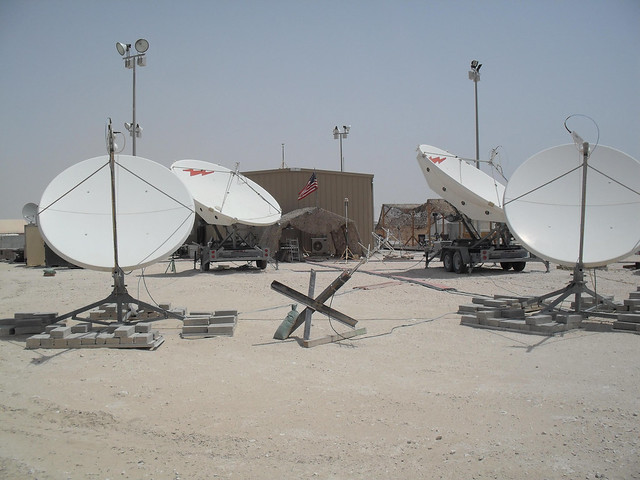
U.S. Air Force awards Integral Systems $6.99M contract for Rapid Attack Identification, Detection, and Reporting System to provide near real-time detection, characterization, geolocation, and electromagnetic Interference reporting for critical satellite communication systems.
[SatNews – 04/14/2011]
Dynetics and Pratt & Whitney join Rocket City Space Pioneers team competing for Google $30M Lunar X Prize to be awarded to first team to build and launch to the moon a privately funded spacecraft capable of completing a series of exploration and transmission tasks.
[SatNews – 04/14/2011]
MDA signs contract worth more than $40M to provide technology support for satellite communications and information service for a confidential customer.
[Windsor Star – 04/14/2011]
92,708 total registered attendees for 2011 NAB show in Las Vegas, with 25,691 international attendees and 1,314 news media, beating 2010 final attendance of 88,044.
[SatNews – 04/13/2011]
German aerospace contractor approved for taking lead role in designing European data relay satellite to promptly relay images of Earth from orbiting spacecraft back to ground stations.
[Spaceflight Now – 04/13/2011]
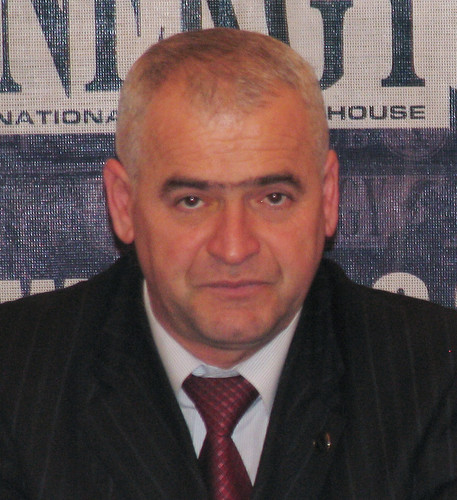
Top Azerbaijani official says country will launch communications satellite in 2012.
[RFE/RL – 04/13/2012]
Russia plans to test a next-generation spacecraft, build a new cosmodrome and even consider a manned mission to Mars after 2035.
[R&D Magazine – 04/13/2011]
China Academy of Launch Vehicle Technology announces launch of eighth satellite of the Beidou-2 global navigation system aboard a Long March 3A rocket on April 10, 2011.
[Examiner – 04/13/2011]
RRSAT grows global broadcast network to over 590 channels featuring SD, HD, and 3D formats and increased number of playout centers in Israel and U.S.
[PR Newswire – 04/13/2011]
Arqiva will launch dedicated DVB-S2 MPEG-4 shared platform at Los Angeles teleport, affording broadcasters and mobile providers access to 100% of U.S. cable headends via SES WORLD SKIES’ AMC-10 satellite.
[TMCnet – 04/13/2011]
Raytheon leads team bidding on U.S. Air Force Launch and Test Range System (LTRS) Integrated Support Contract (LISC).
[Defense – Aerospace – 04/13/2011]
Canadian Radio-television and Telecommunications Commission approves merger of XM Canada and Sirius Canada.
[Satellite Today – 04/13/2011]
Intelsat’s New Dawn African satellite rescheduled for April 22 launch.
[Engineering News – 04/12/2011]
SES ASTRA Platform Services opens new playout centre near Munich, significantly expanding capabilities to provide broadcasters and production houses around the world with state-of-the-art playout and platform services.
[SatNews – 04/12/2011]
Harris to deliver shipboard satellite communications terminals to Canadian Navy.
[Satellite Spotlight – 04/12/2011]
SES WORLD SKIES announces AMC-3 C-band capacity deal with Weigel Broadcasting to deliver new digital ME TV channel to broadcast stations and viewers across U.S.
[Business Wire – 04/12/2011]
GMPCS unveils IsatTruck vehicular satellite phone package.
[PR Web – 04/12/2011]
TeleCommunications Systems selected as participant in FCSA contract allowing government agencies to procure services from commercial satellite services providers.
[Market Wire – 04/12/2011]
NSR press release – Revenues for Broadband Satellite Satellite Services to Exceed S$9 Billion by 2020.
[NSR – 04/12/2011]
GlobeCast selects Eurobird 9A to launch HD distribution platform.
[Indian Television – 04/12/2011]
Level 3 buys Global Crossing in effort to create a networking giant.
[Business Insider – 04/11/2011]
Maiden voyage of Ocean Star Pacific, first ship of the first national cruise line based in Mexico, to offer MTM satellite communications VSAT, crew calling, and Internet services.
[PR Newswire – 04/11/2011]
Qatar plans early 2013 launch of its high-powered communications satellite Es’Hail, being built under joint investment with Eutelsat.
[Gulf Times – 04/11/2011]
TerreStar GENUS satellite-enabled cellular smartphone provides expanded voice and data roaming coverage for mobile users.
[SatNews – 04/10/2011]
Iran’s claims about satellite service raise difficult question for ITU – “Can regulators refuse to accept word of sovereign nation about its own assets even if they are convinced it is lying?”
[Spacenews – 04/08/2011]
NSR Report “Broadband Satellite Markets” – VSAT networking and broadband access continue gains; a turning point for IP trunking.
[NSR – May 2011]
NSR Report “Global Satellite Manufacturing and Launch Markets” – 109 payloads were carried by 74 launch missions worldwide over the past 12 months, down from 2009 by 6.5%.
[NSR – May 2011]
Raytheon seeks new applications for System designed to communicate with deeply submerged swiftly moving submarines using satellites and underwater communications systems tied to buoys, since Navy has yet to come to decision on deployment.
[National Defense Magazine – May 2011]
NSR upcoming – HTS and KA-SAT: “Changing the European Telecom Landscape” – An Interview with Eutelsat.
[gotomeeting – May 24, 2011]

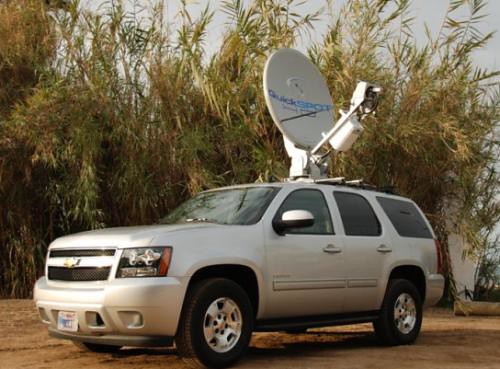


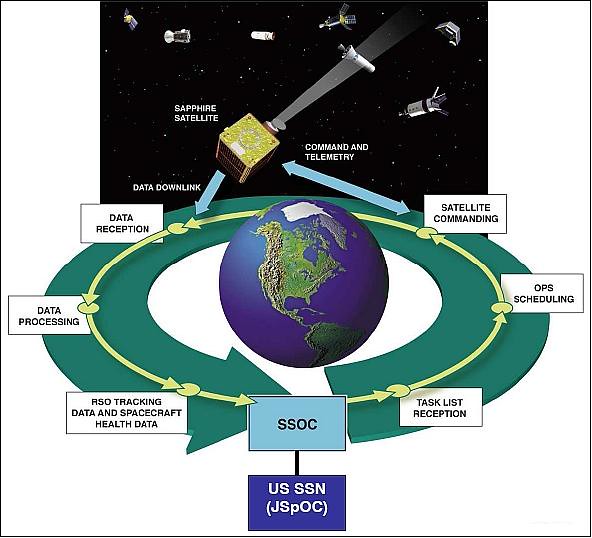

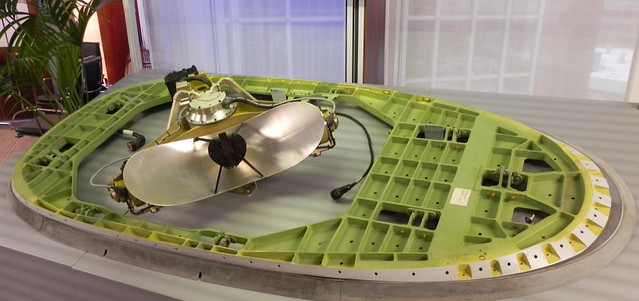

 No. 8 at the Ofunato City Hall to connect the communication line of up to 768 Kbps between the City Hall and the Tsukuba Space Center via KIKU No. 8 in cooperation with the National Institution of Information and Communications Technology (NICT) based on a request from the Ministry of Education, Culture, Sports, Science and Technology, which received a petition from Ofunato City, Iwate Prefecture.
No. 8 at the Ofunato City Hall to connect the communication line of up to 768 Kbps between the City Hall and the Tsukuba Space Center via KIKU No. 8 in cooperation with the National Institution of Information and Communications Technology (NICT) based on a request from the Ministry of Education, Culture, Sports, Science and Technology, which received a petition from Ofunato City, Iwate Prefecture.
